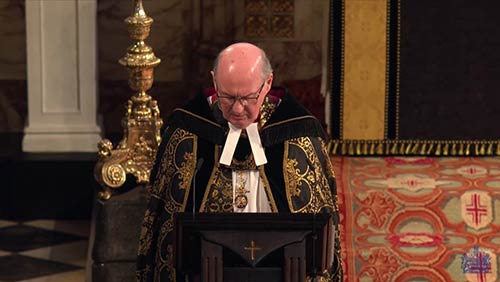
There appear to me to be at least three different liturgical speaking styles using a printed text.
Reading authorised texts
On a lot of online commentary, the Dean of Windsor’s presiding at Prince Philip’s funeral has been held up as presenting, in that service, a masterclass in the presentational style of reading liturgical texts. You need to inhabit the texts, and bring them to life in the particular context with these particular people. You need to get the right tone for the rite: formal but not aloof. Serious when appropriate. Simple and reverent.
Reading from the Bible
A recent post from an e-friend connects to the above as a different presentational style. He wrote about the reading from the Bible in services. The striking point was his statement that:
I hope lectors take note of the proper way to read a lesson… not making eye-contact as if delivering a speech of one’s own composition!
Rev. Tobias Haller
Reading from the Bible, the reader needs to understand the text and read it in such a way that listeners can make sense of it. But, Fr Tobias makes an important point (hyperbole or not) – you are not pretending that this is your text. A woman can read a text presented as a man’s; a man can read a text presented as a woman’s – and so forth. I think that people listening should be able to follow the reading without having the text in front of them (note the word “listening” in that sentence). We say, “Hear what the Spirit is saying to the Church”, not, “Read what the Spirit is saying to the Church.”
I write more about reading at worship in my (free online) book, Celebrating Eucharist, and the chapter, The Proclamation.
Preaching
Preaching is a yet different presentational style. Some, of course, preach extemporarily. This post is about different presentational styles using a written text. Some, when preaching, read monotonously from their own produced text in the manner of a prosaic, academic paper. That is not the purpose of the homily in a service. This is to connect the World with our contemporary context. It is to help “Hear what the Spirit is saying to the Church.”
The style is seen well in, say, the speeches of Obama. Or watch a good news presenter on TV. They are working from a written text – often written by themselves – but we are addressed with an immediacy. They are speaking to us.
You must know your text. If you do not remember what you are going to say, how do you expect people in your congregation to remember. One technique I have seen is to read aloud the last paragraph of your sermon, then the last two paragraphs, then go back and read the last three paragraphs (you have now read your final paragraph aloud three times). Keep working this way to the start of your sermon. Having done this, as you get into preaching it, you are more and more confident as you get further into it as you have gone over it more and more the further along you are.
Again, my chapter, The Proclamation, may help.
Reading authorised texts 2
When it comes to reading aloud authorised, required prayers, there is, yet again, a different presentational style. We need to make sense of the text. We need to articulate the text so that others can understand it. We need to be praying the text – making the text our own, inhabiting the text. We need to be proclaim the text in such a way that others can make this their own prayer (without them following the written text – how often do those gathered for a meal get the written text of the Grace before this meal – those gathered for the meal make it their own and do so with a shared, “Amen.”). But, we who preside, need to also be clear in our presentational style that this is not MY prayer; this is the Church’s prayer.
I have a practice when presiding at the Eucharist of having the text of the Eucharistic Prayer lying flat on the altar. That is because I prefer the altar to be as uncluttered as possible. But I do understand those who suggest that using a book on a stand is a visible reminder that this is a prayer we have all agreed to – it is not the presider’s personal prayer that the congregation is listening to. Somehow, our presentational style, our pitch, pace, volume, inflection needs to make clear that this is a different text to the sermon, to the Bible reading, to The Prayers, and so forth.
Again, there is a chapter in my book that may help further: The Great Thanksgiving
What do you think?
.


